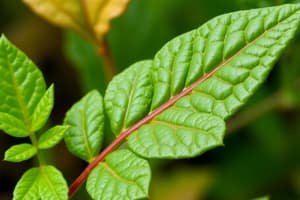Podcast
Questions and Answers
Which characteristic is typical of non-vascular plants?
Which characteristic is typical of non-vascular plants?
- They typically rely on spores for reproduction. (correct)
- They have true roots, stems, and leaves.
- They reproduce primarily using seeds.
- They are highly resilient to environmental changes.
What is a key evolutionary advantage of vascular plants over non-vascular plants?
What is a key evolutionary advantage of vascular plants over non-vascular plants?
- They have developed vascular tissue that facilitates nutrient movement. (correct)
- Vascular plants can perform photosynthesis more efficiently.
- Vascular plants are always larger in size.
- They are exclusively found in dry habitats.
Which type of environment do non-vascular plants generally require to thrive?
Which type of environment do non-vascular plants generally require to thrive?
- Moist environments. (correct)
- Dry and arid environments.
- Saltwater habitats.
- High altitude regions.
What role do both vascular and non-vascular plants play in ecosystems?
What role do both vascular and non-vascular plants play in ecosystems?
Which statement correctly differentiates vascular plants from non-vascular plants?
Which statement correctly differentiates vascular plants from non-vascular plants?
Which phylum is characterized by palm-like leaves and cone-like reproductive structures?
Which phylum is characterized by palm-like leaves and cone-like reproductive structures?
Which of the following is NOT a characteristic of vascular plants?
Which of the following is NOT a characteristic of vascular plants?
What type of plants are included in Phylum Anthophyta?
What type of plants are included in Phylum Anthophyta?
Which phylum contains the only living species known for its fan-shaped leaves?
Which phylum contains the only living species known for its fan-shaped leaves?
What defines non-vascular plants compared to vascular plants?
What defines non-vascular plants compared to vascular plants?
Which plant phylum lacks true roots, stems, and leaves?
Which plant phylum lacks true roots, stems, and leaves?
Which phylum is known for its reproductive strategy involving seeds contained within cones?
Which phylum is known for its reproductive strategy involving seeds contained within cones?
Which phylum includes plants characterized by their fronds and reproduction via spores?
Which phylum includes plants characterized by their fronds and reproduction via spores?
Flashcards
Non-vascular plant characteristic
Non-vascular plant characteristic
Small plants that generally lack true roots, stems, and leaves, and usually require moist environments to thrive.
Vascular plant reproduction
Vascular plant reproduction
Many vascular plants reproduce using seeds.
Non-vascular plants reproduction
Non-vascular plants reproduction
Non-vascular plants typically utilize spores for reproduction.
Vascular plant resilience
Vascular plant resilience
Signup and view all the flashcards
Vascular Tissue Importance
Vascular Tissue Importance
Signup and view all the flashcards
Vascular Plants
Vascular Plants
Signup and view all the flashcards
Non-Vascular Plants
Non-Vascular Plants
Signup and view all the flashcards
Xylem
Xylem
Signup and view all the flashcards
Phloem
Phloem
Signup and view all the flashcards
Phylum Pteridophyta
Phylum Pteridophyta
Signup and view all the flashcards
Phylum Anthophyta
Phylum Anthophyta
Signup and view all the flashcards
Spores
Spores
Signup and view all the flashcards
Seed
Seed
Signup and view all the flashcards
Study Notes
Vascular Plants
- Vascular plants possess specialized vascular tissues (xylem and phloem) for transporting water, minerals, and nutrients. This allows for taller growth and wider distribution than non-vascular plants. Typical features include roots, stems, and leaves.
- Phylum Pteridophyta (Ferns): Characterized by fronds and vascular tissues; reproduce via spores.
- Phylum Lycophyta (Club Mosses and Quillworts): Have vascular tissue and sporangia, but less developed than ferns.
- Phylum Coniferophyta (Conifers): Reproduce using seeds in cones; primarily woody, evergreen trees and shrubs (e.g., pines, spruces, firs).
- Phylum Ginkgophyta (Gingko): A single extant species with fan-shaped leaves and a unique reproductive method.
- Phylum Cycadophyta (Cycads): Ancient group with palm-like leaves and cone-like reproductive structures.
- Phylum Anthophyta (Flowering Plants): Largest and most diverse phylum, characterized by flowers, fruits, and seeds; includes monocots (one seed leaf) and dicots (two seed leaves).
Non-Vascular Plants
- Non-vascular plants lack xylem and phloem, restricting their size and water/nutrient transport efficiency. Generally small and low-growing.
- Phylum Bryophyta (Mosses): Lack true roots, stems, and leaves; require moist environments for reproduction and survival; reproduce via spores.
- Phylum Hepatophyta (Liverworts): Another non-vascular group; often have lobed or leaf-like structures; reproduce via spores.
- Phylum Anthocerophyta (Hornworts): Less common; have a distinctive horn-shaped sporangium; a photosynthetic structure resembling a liverwort with spores.
Differences between Vascular and Non-Vascular Plants
- Vascular Tissue: Vascular plants have xylem and phloem for efficient water and nutrient transport, while non-vascular plants rely on diffusion, limiting their size.
- Height and Structure: Vascular plants are generally taller and more complex, with specialized roots, stems, and leaves; non-vascular plants are smaller and lack these specialized structures.
- Reproduction: Vascular plants often use seeds for reproduction, while non-vascular plants use spores.
- Habitat: Non-vascular plants prefer moist environments, while vascular plants exhibit greater habitat adaptability due to their vascular systems.
- Resilience: Vascular plants tend to be more resilient to environmental changes because their vascular systems effectively transport water, minerals and nutrients. This is often not true for non-vascular plants.
Further Observations
- Evolutionary History: The evolution of vascular tissue was crucial for plant diversification and adaptation to land.
- Ecological Roles: Both vascular and non-vascular plants provide vital ecosystem roles as producers and habitats.
Studying That Suits You
Use AI to generate personalized quizzes and flashcards to suit your learning preferences.




